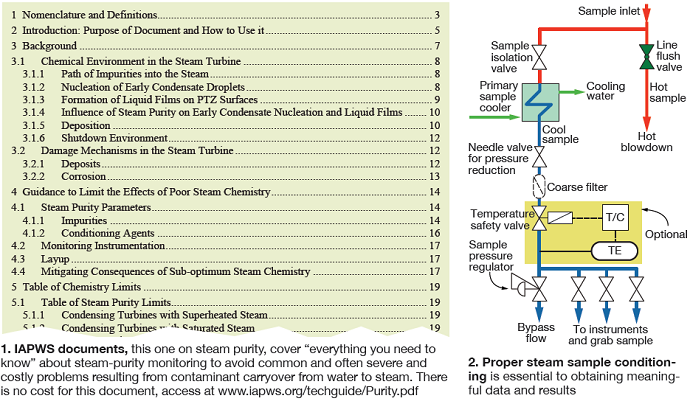If you’re already plugged into the International Association for the Properties of Water and Steam (IAPWS) and have obtained the Technical Guidance Document (TGD), “Steam Purity for Turbine Operations,” read that instead of this article. If not, and your water/steam cycle (HRSG, steam turbine, condenser) is either suffering from deposition and corrosion caused by solids carryover in the steam or you want to avoid it in the future, hopefully this teaser of an article will convince you to get on board with global industry best practices.
The article is sourced from a presentation at the Australasian HRSG Users’ Group (AHUG), Dec 9-10, 2014, delivered by David Addison, principal, Thermal Chemistry Ltd (New Zealand), one of the top consultants worldwide in this area and a member of the IAPWS Power Plant Chemistry Working Group.
Problems caused by mechanical and vaporous carryover of contaminants in the water to the steam cycle are well known and have been covered in the pages of CCJ and elsewhere: They begin with deposition and corrosion of HRSG tubes and steam-turbine surfaces and ultimately, through various damage mechanisms, lead to material deterioration, performance deterioration, extensive downtime for removing deposits, and catastrophic failures.
The culprits usually are one or a combination of the following: inadequate feedwater treatment, incorrect steam-drum level setpoints, poor control over drum operating pressure, condenser leakage, desuperheater spray-water contamination, and/or inadequate original design of the drum’s steam/water separator.
The IAPWS TGDs consolidate best practices worldwide. Key elements are the critical need for online and proper superheated steam sampling and analysis and proper carryover tests (covered in a separate TGD) conducted every six to 12 months. Unfortunately, these tests are often not done at all at many power stations.
Importantly, the TGD is not a one-size-fits-all approach. Rather, about a third of the document (Fig 1) shows how to customize and adapt the practices for different types of plants (such as combined cycles, nuclear, geothermal), different water-chemistry situations, and different system metallurgies (for example, plants with copper and/or aluminum components).
Steam sampling and analysis should include:
- Saturated steam, with all pressure stages sampled (normally grab samples).
- Post spray-water/attemperation superheated steam (online analysis but cross-fed to a saturated steam line) across all pressure stages—that is, with the final steam-quality sample point downstream of the spray-water system.
- Reheated steam (online analysis, hot reheat outlet, post spray).
- Proper sample conditioning (Fig 2).

This TGD, combined with earlier ones reviewed by CCJ, Corrosion Production Sampling and Analysis for Fossil and Combined-Cycle Plants and Instrumentation for Monitoring and Control of Cycle Chemistry for the Steam/Water Circuits of Fossil-Fired and Combined-Cycle Power Plants should, according to Addison, give you “everything you need to know”—a compendium of international best practices to avoid unnecessary downtime, poor performance, and catastrophic failures resulting from steam/chemistry issues. CCJ



